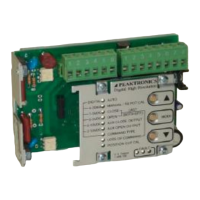15
On power up, or following a reset using the
PACS
®
Reset parameter, the PACS
®
Control Register
parameter is cleared to $00. If a PACS
®
timeout occurs,
bits 0, 1, and 2 will be cleared by the DHC controller. A
PACS
®
timeout occurs when the DHC controller does not
receive a requesting ADU (which can be a broadcast
command) from the bus after a certain amount of time. The
time allowed is set using the PACS
®
Timeout Setting
parameter.
Note that the PACS
®
Timeout Setting parameter
is also cleared on power up and must be set to a non-zero
value before bits 0 to 2 can be changed. If the timeout
setting is zero when the PACS
®
Control Register
parameter is written to a DHC-400 controller, the DHC-400
will automatically set the timeout value to 4 (2 seconds) if
bit 0, 1, or 2 are set to "1".
Since bits 0 to 2 allow the bus to run the actuator,
the DHC controller must be in the AUTO mode (see
CONTROL HIERARCHY in Section I) before it acts on
these bits. The values of bits 0 to 2 are not affected if the
DHC is put in a mode other than AUTO.
Bit 0 - "command override control"
When this bit is "0", the DHC controller will use
the Analog Command Input parameter (see
Section II) to control the valve. When this bit is
"1", the DHC will use the PACS
®
Command
Input parameter to control the valve. If the DHC
is configured for a Digital command type, this bit is
essentially ignored since there is no analog
command signal. In this case, the DHC will use
the PACS
®
Command Input regardless of the
value of bit 0.
Bits 1 & 2 - "PACS
®
manual control"
These bits are used to directly control the DHC
outputs in the same way as the MANUAL mode
from the DHC control panel. The bits are assigned
as follows:
2 1
0 0
PACS
®
manual control disabled
0 1
turn on M2
1 0
turn on M1
1 1
turn off M1 and M2
When both bits are "0", manual control from the
bus is disabled. When either bit is set to "1", the
Mode parameter (see Section II) will read 10
decimal to indicate PACS
®
Manual mode. Also,
bit 0 and the command input signal (analog or
digital) are ignored, which gives "PACS
®
manual
control" priority over "command override control".
The M1 output is the one that turns on with the ▲
button when the DHC controller is in the
MANUAL mode, and the M2 output corresponds
to the ▼ button. The direction the actuator moves
depends on the wiring to the actuator motor.
CAUTION! These bits turn on the DHC outputs;
power to the output is maintained until turned off
via the bus. Limit switches in the actuator will be
required to disconnect power at the mechanical
limits of the actuator. Upon reaching a limit
switch, or a mechanical limit, the DHC controller
will detect a stall which can be read using the alarm
flags parameters (see Section II).
Bits 3 & 6 - unassigned
Bits 3 and 6 are unassigned and can be set to "1" or
"0", but their values perform no function. Using
these bits is not recommended since future versions
of the DHC Series may assign these bits to other
control functions.
Bits 4 & 5 - "set loss of command"
When configured for a 4-20mA, 1-5V, 2-10V
(DHC-400 only), or Digital command type, the
DHC controller can detect when the command
signal has been lost. From the DHC control panel,
the DHC can be configured to go to close, go to
open, or turn off the outputs (last position) using
the LOSS OF COMMAND mode. Alternatively,
the DHC can be configured via the bus using bits 4
and 5 as shown below:
5 4
0 1
last position (both outputs off)
1 0
close
1 1
open
These bits will always read zero; to read the
setting, use the Configuration parameter (see
Section II). Setting both bits to "0" has no affect,
and the previous setting remains. The setting is
saved in non-volatile memory, so the setting is
retained until it is changed from the DHC control
panel or via the bus.
Bit 7 - "power monitor"
This bit is set to "0" when the DHC powers up, or
is reset using the PACS
®
Reset parameter. This bit
can only be set to "1" via the bus. After setting this
bit to "1", the bit can be monitored to detect that the
DHC controller experienced a power loss. This is
particularly useful if the bus is being used to
control the DHC outputs - see PACS
®
Command
Input and PACS
®
Timeout Setting parameters.
Since the PACS
®
Control Register parameter is
divided into groups of bits, setting particular bits without
affecting others can be more effectively done using the

